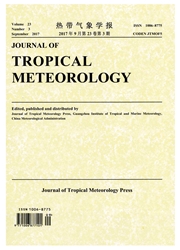

 中文摘要:
中文摘要:
热带降雨测量的每日、每周的海表面温度数据扫描观察系统传感器的辐射计地球的使命(TRMM ) 微波成像器和先进微波被用作在 mesoscale 内在的海表面强迫模仿越过华南海搬到 2003 的台风 Dujuan 的数字模型。数字结果在大气的风地里处于差别在台风中心结果附近显示出那不同 SST,显示模型有对 SST 的快、明显的回答。不同 SST 在某种程度上影响 Dujuan 的紧张和轨道并且在眼睛附近在它的降水和潜伏的热流动上有重要影响。对 Dujuan 的 SST 影响被改变在海洋表面和空气之间的潜伏的热流动在上面主要完成。
 英文摘要:
英文摘要:
Daily and weekly sea surface temperature data of Tropical Rainfall Measuring Mission (TRMM) Microwave Imager and Advanced Microwave Scanning Radiometer-Earth Observing System sensors are used as forcing of the underlying sea surface in the mesoscale numerical model to simulate Typhoon Dujuan that moved across the South China Sea in 2003. The numerical results show that different SSTs near the typhoon center result in differences in the atmospheric wind field, indicating that the model has a fast and obvious response to SSTs. Different SST influences the intensity and track of Dujuan to some degree and has significant impacts on its precipitation and latent heat flux near the eye. The SST influence on Dujuan is mainly fulfilled by changing the latent heat flux between the ocean surface and the atmosphere above.
 同期刊论文项目
同期刊论文项目
 同项目期刊论文
同项目期刊论文
 Impacts of tropical Indian Ocean SST on the meridional displacement of East Asian jet in boreal summ
Impacts of tropical Indian Ocean SST on the meridional displacement of East Asian jet in boreal summ Modulation of Low-latitude West Wind on Abnormal Track and Intensity of Tropical Cyclone Nargis (200
Modulation of Low-latitude West Wind on Abnormal Track and Intensity of Tropical Cyclone Nargis (200 Interdecadal modulation of the influence of La Nina events on mei-yu rainfall over the Yangtze River
Interdecadal modulation of the influence of La Nina events on mei-yu rainfall over the Yangtze River Effects of the East Asian summer monsoon on tropical cyclones genesis over the South China Sea on an
Effects of the East Asian summer monsoon on tropical cyclones genesis over the South China Sea on an The impacts of the Summer Asian Jet Stream biases on surface air temperature in Middle Eastern China
The impacts of the Summer Asian Jet Stream biases on surface air temperature in Middle Eastern China The Impact of Indian Ocean variability on high temperature extremes across south of Yangtze River Va
The Impact of Indian Ocean variability on high temperature extremes across south of Yangtze River Va Numerical investigation on propulsion of the counter-wind current in the northern South China Sea in
Numerical investigation on propulsion of the counter-wind current in the northern South China Sea in trengthening of tropical Indian Ocean teleconnection to the Northwest Pacific since the mid-1970s: A
trengthening of tropical Indian Ocean teleconnection to the Northwest Pacific since the mid-1970s: A Asymmetric modulation of the Western North Pacific cyclogenesis by the Madden-Julian Oscillation und
Asymmetric modulation of the Western North Pacific cyclogenesis by the Madden-Julian Oscillation und Decadal variability of twentieth-century El Nino and La Nina occurrence from observations and IPCC A
Decadal variability of twentieth-century El Nino and La Nina occurrence from observations and IPCC A Evaluation of a satellite-derived latent heat flux product in the South China Sea: A comparison with
Evaluation of a satellite-derived latent heat flux product in the South China Sea: A comparison with Dynamics of eddy-driven North Atlantic Oscillations in a latitudinally fluctuating jet: isolated str
Dynamics of eddy-driven North Atlantic Oscillations in a latitudinally fluctuating jet: isolated str Synoptic-Scale Controls of Persistent Low Temperature and Icy Weather over Southern China in January
Synoptic-Scale Controls of Persistent Low Temperature and Icy Weather over Southern China in January 期刊信息
期刊信息
